(Aircel Comics/Malibu Graphics, June - September 1990)
Story: Barry Blair
Art: Dave Cooper
Art: Dave Cooper
Rating: Six of Ten Stars
New York City has been overrun by costumed heroes and villains. Millionaire Donald Lump believes Gun Fury and Ammo can restore some semblance of order, so he coaxes them out of retirement by funding new equipment for them and providing a base of operations. The city has been overrun by costumed heroes and villains, and only Gun Fury can restore some semblance of order!
Gun Fury and Ammo were the stars of a ten-issue superhero parody series that ran from January to October of 1989. There are hints that, despite the series wrapping up with the heroes retiring at the end of #10, there were course adjustments in the final 2-3 issues, because the creators knew cancelation was looming due to low sales.
In mid-1990, Gun Fury and Ammo returned for four more whacky adventures of questionable taste, brought to us by the original creative team of Barry Blair (writer and creator) and Dave Cooper (artist and sometime co-plotter) in the limited series "Gun Fury Returns". In keeping with the tone of the original series, "Gun Fury Returns" is full low-brow spoofs of popular comic book characters and dominant industry business and storytelling trends. (You can read my thoughts about the original series by clicking here [issues 1-5] and here [issues 6-10].
One thing that immediately jumps out if you put the four issues of this series side-by-side is that the covers get progressively more unappealing and downright ugly. Take a look:
Does the interior artwork and stories follow this same progression, you may ask? Generally no--except for #4 where artist Cooper didn't do the excellent ink washes that graced all the pages up until that point. There is a fairly steady level of quality throughout the series... which is both good and bad.
"Gun Fury Returns" follows the rhythm that the first series fell into as of issue #6: Each issue features a self-contained story, with Gun Fury and Ammo being the only recurring characters and everything being tied together with a thin subplot that's little more than a running joke. In this mini-series, the subplot is about Gun Fury's hemorrhoids, which should tell you something about the level of humor present within the pages.
The first issue of the mini-series is perhaps the weakest. I remember reading it back in 1990 and being disappointed in it. I particularly found the Batman spoof that is the central feature of the issue to be overly juvenile and crass (even by the standards of the previous series), as well as a little trite and redundant since Gun Fury and Ammo were already something of a Batman spoof.
Thirty years later, I still find "Batman and Throbbin" and the related, embarrassingly obvious scatological humor to be lame, but, because there have been one redundant Batman movie after another, I also feel like this target is even more deserving than it was Back In The Day. The Alfred-type character made me chuckle back then, and it is still one of the more amusing (and darker) elements of the parody.
Issue #2 offers an X-Men spoof -- The Yes Men. The story here is an improvement over the first issue, and the subplot involving Gun Fury's hemorrhoids actually serves a purpose other than providing some mildly gross gags. This issue's main target was the seemingly never-ending, ever-present X-Men crossovers that Marvel was dishing out during the late-1980s--and into the 1990s, as well as the big-boobed women that became increasingly common in the pages of comics. I was never much of an X-Men reader--the mutant stories in "Marvel Comics Presents" was all that I followed--and the incessent crossovers into titles I DID follow were a contributing factor to my getting away from Marvel Comics (except when I had to read them for work purposes). For this reason, some of the humor in this issue may be lost on me, but them being cast as basically a fetish sex club was something I found very amusing. Further, over all, the timing of the gags were better in this issue than any one previously; Blair and Cooper seem to have found a perfect rhythm... and this carries through to the end of the series.
Issue #3 skewers two indie comics properties that exploded in popularity during the 1980s, ElfQuest and the Teenage Ninja Mutant Turtles. This issue features what is probably the most mature industry commentary featured in all 14 issues in which Gun Fury appeared. Wrapped within the usual, off-color gags, the story takes shots at how art can take a back seat to creativity (with caricatures of ElfQuest creators Wendi and Richard Pini callously exploiting dog-riding elves to enrich themselves) and how putting greed above all else will eventually come back to haunt and destroy creators (or at least their reputation and stature).
This issue may stand out from the rest, in part because the villains here are satirical versions of friends of Blair--and they would eventually hire him to contribute to their expanding ElfQuest fiefdom, in the "New Blood" spinoff series. More care and less vitriol was probably infused into this script than any of the others--although I assume the Pinis were consulted on the jokes, because Richard comes off REALLY badly. (For what it's worth, I had some small dealings with Richard Pini during the early mid-1990s and my last halfhearted attempts to break into comics. He came across as a nice guy.)
The mini-series closes with a Spider-Man spoof, including the sentient suit from "Secret Wars" (which eventually became an even dumber concept via the invention of the Venom and Carnage characters). Story-wise, this issue is on-par with #3, and Blair's comedy version of Peter Parker at his most whiny is hilarious. The only disappointing aspect of this issue is that the art feels unfinished and a bit empty, because the excellent ink wash finishes are not applied here as they had been in the previous 13 issues. (The panel that opens this post is from "Gun Fury Returns" #4.)
Like most satire, "Gun Fury Returns" is, to a large extent, a product of its time. Much of the humor will be silent or even baffling to readers who aren't familiar with tropes or controversies or fads that permeating comic books and the comic book industry in the late 1980s/early 1990s. The original 10-issue series was broader based in its humor, in the sense that the pot-shots at fans and creators and publishers involve stereotypes and issues that continue to present day, so in that sense its held up better to the passage of time. As a snap-shot of history and as a irreverent and off-color walk down memory lane for Gen-X comics fans, "Gun Fury Returns" still entertains.
--










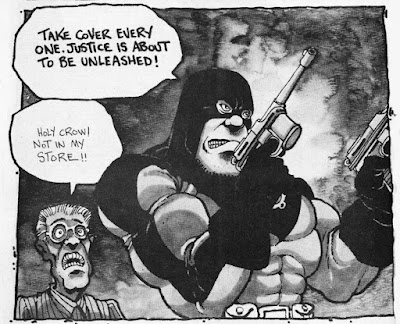

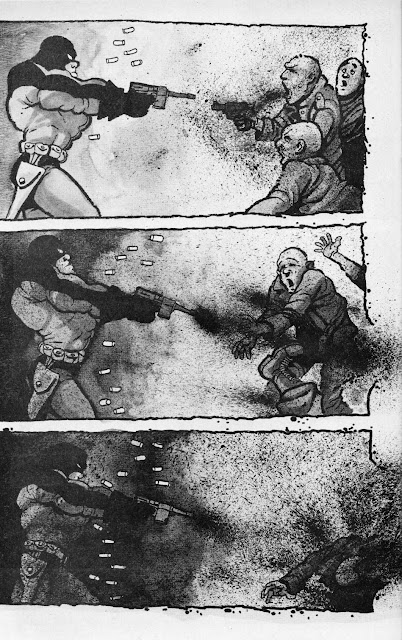
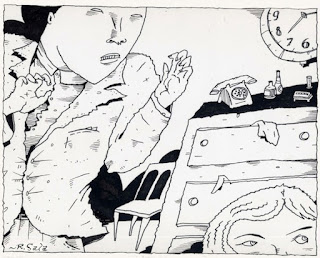
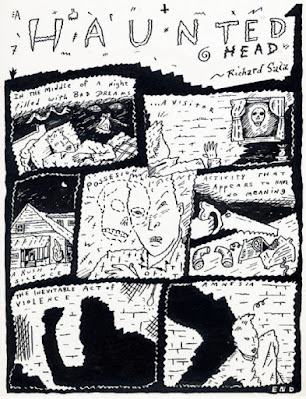









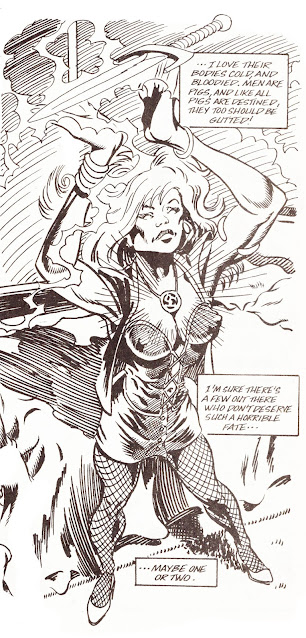

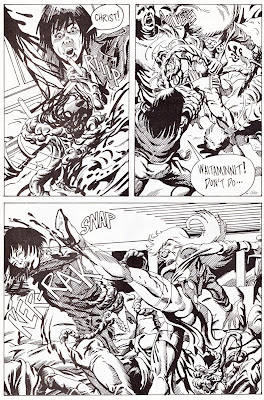
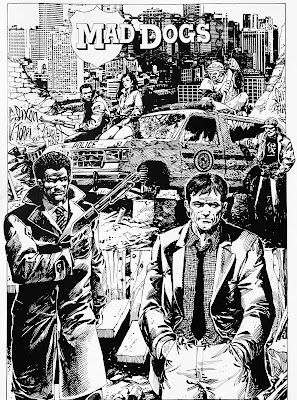
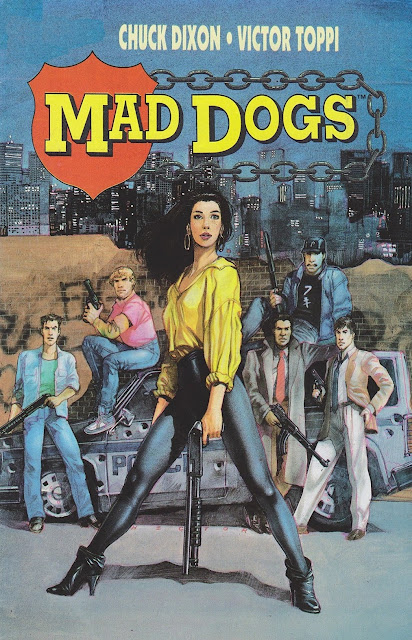
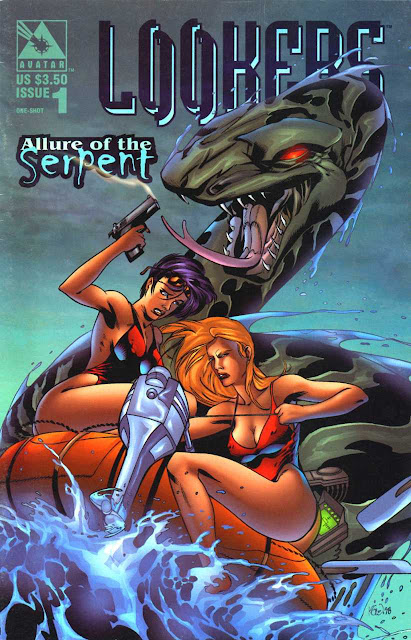









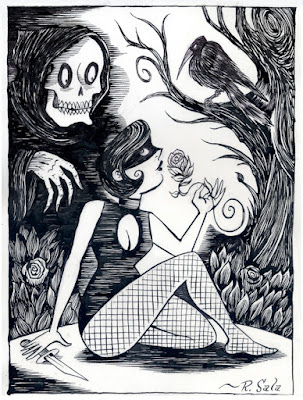


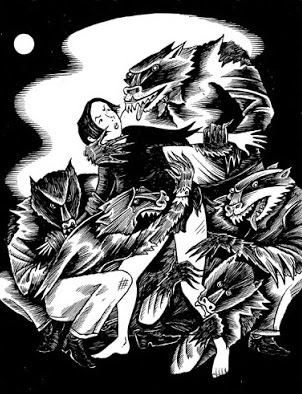



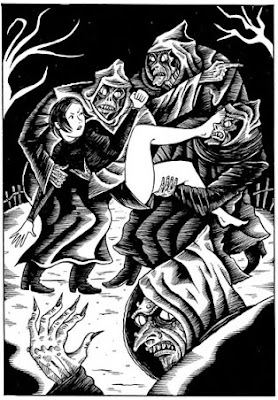
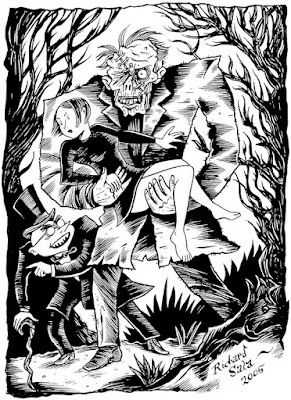
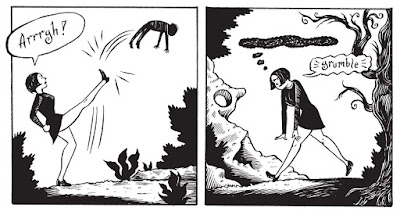




















.jpg)
